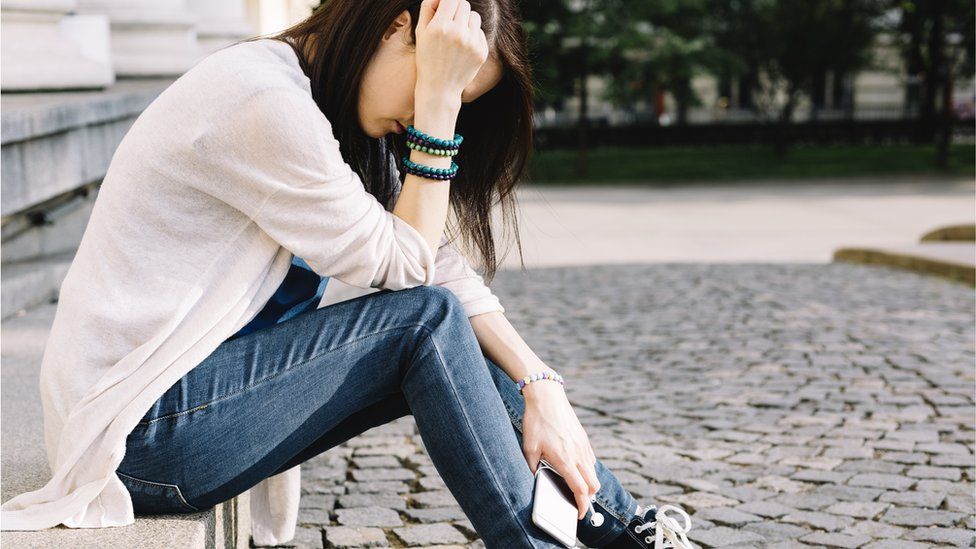'Steep rise' in self-harm among teenage girls
- Published

There has been a steep rise in reports of self-harm among girls aged 13 to 16, according to a study of data from GP practices across the UK.
The BMJ study, which looked at figures from 2011-2014, said GPs could be getting better at picking up self-harm.
But it was likely that rising stress and psychological problems in young people were also behind the trend.
The NSPCC said giving children support early could be a matter of life or death.
Since 2001, girls have had much higher rates of self-harm than boys - 37.4 per 10,000 compared with 12.3 in boys.
While self-harm rates stayed constant among 10- to 12-year-olds and 17- to 19-year-olds, there was a 68% increase among 13- to 16-year-olds over the three-year period studied.
This took the rate in girls from 45.9 per 10,000 in 2011 to 77 per 10,000 in 2014.
The researchers, from the University of Manchester, looked at data for nearly 17,000 patients from more than 600 GP practices.
Sophie Martin began self-harming when she was 12 years old after being bullied at school.
When her dad took her mum to court in a custody battle, she blamed herself.
"I thought it was my fault, I had to be punished for it. And that's when I started self-harming," she told BBC News.
She said: "It was a release, it was painful, but it made me feel better."
Things went from bad to worse for Sophie when she confided in her best friend about how she felt.
"She told her boyfriend at the time and then he posted it all over Facebook. That made the bullying worse," she said.
After her mum found out what was happening, she went to see a GP but it was about a year before she could access mental health services.
'Still have the fear'
By that time she had moved schools and also felt like she was leaving her past behind.
But a couple of years later, when a relationship broke down, she began self-harming again.
The self-harm charity Harmless took her on and gave her one-to-one sessions with a psychologist.
"Talking to someone really helped. You don't want to say to your mum 'I hate myself, I hate my body, I hate how I look'," Sophie says.
Two years on, things are looking up. She is now in her last year of a certificate in beauty therapy.
"I'm great now. My anxiety has really dropped. I still have the fear that I will relapse, sort of.
"That's why I like to keep Harmless there so I could message them straight away and say I need to see someone."
'School stress'
Nav Kapur, study author and professor of psychiatry and population health at the University of Manchester, said parents and young people should not be unduly alarmed by the findings.
"We know that for many young people things get better and they no longer hurt themselves as adults.
"But of course we must take self-harm seriously; it's important to understand its underlying causes."
The study also found that young people living in the most deprived areas were the least likely to be referred to specialist mental health services.
Self-harm is seen as the biggest risk factor for subsequent suicide, which is now the second most common cause of death in the under-25s worldwide.
The NSPCC charity said the figures were "heart-breaking". It held more than 15,000 counselling sessions about self-harm last year.
"Self-harm can often be an expression of a deeper problem, which is why early intervention services to support these children are vital.
"Without this, the consequences really can be a matter of life or death."
Tom Madders, director of campaigns at YoungMinds, said school stress, body-image issues, the pressure created by social media and difficult experiences in childhood could all have an impact on the mental health of teenage girls.
He said: "As a society, we also need to do more to prevent mental health problems from developing in the first place.
"To start with, we need to rebalance the education system, so that schools can prioritise wellbeing and not just academic performance."
What adults can do to help a child who is self-harming
- Show you understand
- Talk it over
- Discover the triggers
- Build their confidence
- Show you trust them
- Choose who you tell carefully
- Help them find new ways to cope
How to spot warning signs
Look for physical signs such as cuts, bruises, burns and bald patches from pulling out hair. These are commonly on the head, wrists, arms, thighs and chest.
The emotional signs are harder to spot:
- depression
- tearfulness and low motivation
- becoming withdrawn and isolated, for example wanting to be alone in their bedroom for long periods
- sudden weight loss or gain
- low self-esteem and self-blame
- drinking or taking drugs
Source: NSPCC
- Published17 September 2017
- Published10 July 2017
- Published9 December 2016